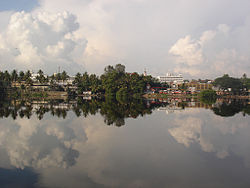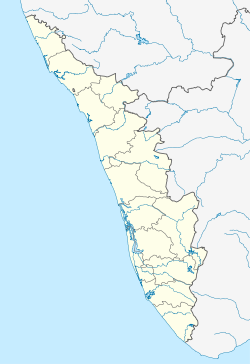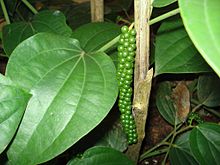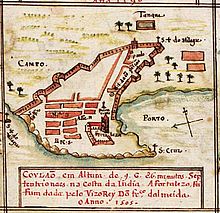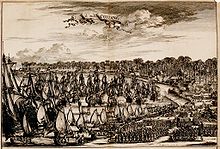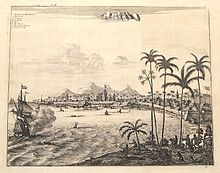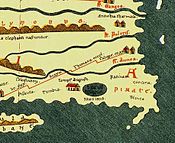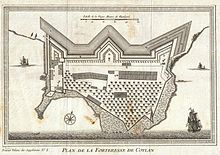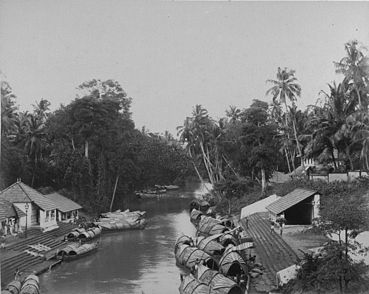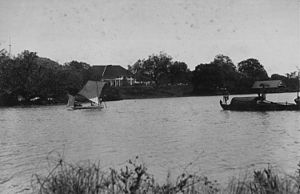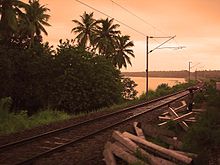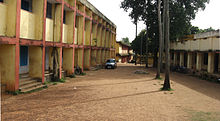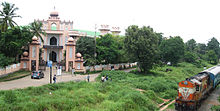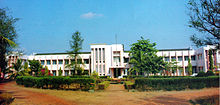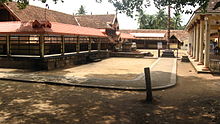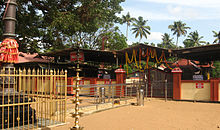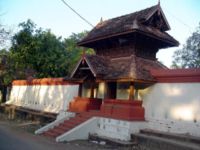- Kollam
-
Kollam (കൊല്ലം)
Quilon
— city — A view of Kollam Coordinates 8°53′N 76°36′E / 8.88°N 76.60°ECoordinates: 8°53′N 76°36′E / 8.88°N 76.60°E Country India State Kerala District(s) Kollam Mayor Prasanna Earnest City Police Commissioner T.J.Jose IPS Population
310,091[1] (2001[update])
• 5,936 /km2 (15,374 /sq mi)
• 508,656Sex ratio 1069 ♂/♀ Official languages Malayalam, English Time zone IST (UTC+05:30) Area
58.18 square kilometres (22.46 sq mi)
• 3 metres (9.8 ft)
Website www.cityofkollam.in Kollam (Malayalam: കൊല്ലം, Kollam), often anglicized as Quilon, is a city in the Indian state of Kerala. The city lies on the banks of Ashtamudi Lake on the Arabian sea coast and is situated about 71 kilometres (44 mi) north of the state capital, Thiruvananthapuram. It is the headquarters of the Kollam district.
Kollam is the 5th largest city in Kerala, after Thiruvananthapuram, Ernakulam, Kozhikode and Thrissur and is known for cashew processing and coir manufacturing. It is considered to be the southern gateway to the backwaters of Kerala and is a prominent tourist destination. The Kollam urban area comprises of fast developing suburban towns such as Kottiyam in the south, Kundara in the east, and Chavara in the north of the city. Other important towns in the city suburbs are Paravur, Kannanalore and Anchalumoodu. Karunagapally, Chathanoor, and Kottarakkara are major towns within a distance of 25 km from Kollam city centre towards north, south, and east respectively.
Kollam appeared as Palombe in Mandeville's Travels, where he claimed it contained a Fountain of Youth.[2][3] During the rule of the Chera monarchy in southern Kerala, Kollam emerged as the focal point of trade. Kollam continues to be a major business and commercial centre in the central Travancore region of Kerala.
Toponomy
The Malayalam calendar, or Kollavarsham, was created in Kollam at meetings held in the city in 825 CE.[4] The name Kollam is believed to have been derived from the Sanskrit word Kollam, meaning pepper.
History
Kollam was a flourishing port of the Chera Dynasty until the formation of the Venad kingdom, when it became the capital of the independent Venad kingdom.
Kollam during Chera rule
Kollam shares fame with Pattanam (Muziris) as an ancient seaport on the Malabar Coast of India from the early centuries of Before the Christian era.
Kollam had a sustained commercial reputation from the days of the Phoenicians and Ancient Rome. Pliny the Elder (23–79 AD) mentions Greek ships anchored at Muziris and Nelcynda. There was also a land route over the Western Ghats. Spices, pearls, diamonds, and silk were exported to Egypt and Rome from these ports. Pearls and diamonds came to Chera Kingdom from Ceylon and the southeastern coast of India, then known as the Pandyan kingdom.
Part of a series on the Chera dynasty Kings · Uthiyan Cheralathan · Imayavaramban Nedun-Cheralatan · Cheran Senguttuvan · Tagadur Erinda Perumcheral · Yanaikat-sey Mantaran Cheral · Kulashekhara Alwar · Rajashekhara Varman · Rama Varma Kulashekhara Capitals Vanchi Muthur Karur · Muchirippattanam Mahodayapuram · Kulasekharapuram Others Kalabhra interregnum Sangam period Patiṟṟuppattu Ay kingdom Ezhimala Hill Keralavarma (Kulasekhara) Mukundamala Tyndis Jaffna Vellalar Cheraman Perumal Kandalur War Adi Shankara Medieval Chola Empire Kerala school Malayalam calendar Vazhapalli plates After the Cheras Kingdom of Calicut Venad Kolathunadu Kingdom of Cochin Cosmas Indicopleustes, a Greek Nestorian sailor,[5] in his book the Christian Topography who visited the Malabar coast in 550 CE, mentions an enclave of Christian believers in Male (Chera Kingdom). He wrote, "In the island of Tabropane (Ceylon), there is a church of Christians, and clerks and faithful. Likewise at Male Trincomalee in Sri Lanka, where the pepper grows and in the farming community of Kalliana (Kalliankal at Nillackal) there is also a bishop concentrated in Persia in accordance with the Nicea sunnahadose of 325 AD ."[6] The Nestorian Patriarch Jesujabus, who died in 660 CE, mentions Kollam in his letter to Simon, Metropolitan of Persia. However, on close scrutiny of Christian Topography written by Cosmas Indicopleustes, the book does not mention Christianity in Kerala. He says, "The island Taprobanê [Sri Lanka] has also a church of Persian Christians who have settled there, and a Presbyter who is appointed from Persia, and a Deacon and a complete ecclesiastical ritual. But the natives and their kings are heathens. The island being, as it is, in a central position, is much frequented by ships from all parts of India and from Persia and Ethiopia, and it likewise sends out many of its own. And from the remotest countries, I mean Tzinista and other trading places, it receives silk, aloes, cloves, sandalwood and other products, and these again are passed on to marts on this side, such as Male, where pepper grows, and to Calliana which exports copper and sesame-logs, and cloth for making dresses, for it also is a great place of business." Cosmos does talk about the Persian Christians under a Presbyter at Taprobane (TamiraBarni the ancient Name of Sri Lanka).He talks about Male, Trincomalee in Sri Lanka as an important trading port which exported pepper.
However the records from ancient Tamil Kingdoms such as Sangam literature which ruled Kollam such as the Early Pandyan Kingdom or Chera Dynasties never mentioned the existence of Christianity in ancient Kerala prior to 825 CE. Christianity was not a distinct religion to ancient Tamils of Kerala but just a faith order in Jesus (Isha) as Brahma puthra incorporated in Hinduism as broad Vaishnavism practised by Vedic Malayalee Brahmins following the Nicea sunnahadose of 325 AD.
In 825 CE, the Nestorian monks Mar Abo and Mar Proth arrived in Kollam on the invitation of the ruler of the Venad-a feudatory under the Chera kingdom.[7] The two monks received a Royal sanction called "Tarsish-a-palli" near "Korukenikollam" from Chera ruler Rajashekara varman Ayyanadikal Thiruvadikal, as described on the Tharisapalli plates. Special privileges were given to the Ezhavas in the Tarisapalli sasanam. The two monks were instrumental in founding Christian churches with Syrian liturgy in the Malabar coast area distinct from ancient Hinduism. Mar Abo lived his last years at Thevalakkara, and his remains were buried there in the Martha Mariam Orthodox Church.
Kollam Port
Kollam sea port was founded by Mar Abo with sanction from Udayamarthandavarma the Tamil king from Venad otherwise called Ay kingdom in 825 AD instead of re opening the inland sea port(kore-ke-ni kollam) near Backare (Thevalakara) also known as Nelcynda and Tyndis to the Romans and The Greeks and Thondi to the Taamils and is also the foundation of the new city. It is also believed that Mar Abo actually volunteered to the Chera king to create a new sea port town near at Kollam instead of his request for renewing the almost vanishing Tyndis or Nelcynda inland sea port(kore-ke-ni) at Kollam,lying idle without trade for a few centuries because of the Cheras being over run by pallavas in the 6th century AD ending the spice trade from Malabar coast. This allowed Mar Abo to stay for many decades in Chera kingdom and streamline Christian faith in the St.Thomas tradition with Syrian liturgy replacing the Sanskrit and Vedic prayers.
Kollam, the capital of Venad 9th to 12 century AD
The Malayalam Era began in 825 CE; it is named 'Kolla Varsham' after Kollam, because of the importance of Kollam in the 9th century CE. Ayyanadikal Thiruvadikal granted the Tharisapalli plates copper plate grants in 825 CE to Nestorian Monk Mar S(abo)r Iso who he invited to Kollam, transferring to the Tarsish Church and the community in the St. Thomas tradition of Quilon.[8]
A merchant, Soleyman of Siraf of Persia, visited Malabar in the 9th century and found Quilon to be the only port in India used by the huge Chinese ships as their Transhipment hub for their goods on their way from China to the Persian Gulf. The rulers of Kollam (formerly called 'Desinganadu') had trade relations with China and exchanged embassies. According to the records of the Tang Dynasty (618 AD to 913 AD),[9] Quilon was their chief port of call before 7th century AD. The Chinese trade decreased about 600 AD and was again revived in the 13th century.
In 1291, John of Montecorvino, a Franciscan monk, became a priest at Quilon. Friar Jordanus Catalini, who arrived in 1321, effected large-scale Latin Catholic conversions and was appointed Bishop of the Roman Catholic Diocese of Quilon in 1329. Friar Jordanus built a church, called St. Georges Church, with the patronage of Nestorian spice merchants at Jona-ka-puram (the seat of Jordanus Catalini )in Kollam and wrote Mirabilia Descripta. However, after Giovanni de' Marignolli in 1353, this Latin church was converted to a Nestorian church by the Nestorian Christians, and when Portuguese arrived in 1498, only Nestorian Christianity existed in Kerala in a visible way.[citation needed]
Marco Polo, who visited China's Kublai Khan's court, traveled in 1292 through Kollam on his return journey to Venice, and gave an interesting account of the flourishing port of Kollam (coilum, as he called it) and its trade relations inter connectivity with China in the east and Europe to the west. Chinnakada, (China-kada), the city center, was so named after the Chinese merchants. The increase in commercial activity resulted in establishment of a flourishing Chinese settlement at Kollam.[citation needed]
Kollam during Portuguese, Dutch and British conquests (16th to 18th centuries)
The Portuguese were the first Europeans to establish a trading center in Tangasseri, Kollam in 1502, which became the centre of trade in pepper. In the wars with the Moors/Arabs that followed, the ancient church of St Thomas was destroyed. In 1517, the Portuguese built the St. Thomas Fort in Thangasseri, which was destroyed in the subsequent wars with the Dutch. The ruins of the Fort can still be seen in Thangasseri. In 1661, the Dutch took possession of the city. The remnants of the Dutch forts can be found at Thangasseri. In the 18th century, Travancore conquered Kollam, followed by the British in 1795. Thangasseri remains today as an Anglo-Indian settlement, though few Anglo-Indians remain. The Infant Jesus Church in Thangasseri, an old Portuguese-built church, remains as a memento of the Portuguese rule of the area.
Kollam as part of Travancore
Velu Thampi Dalawa of Travancore worked to improve Kollam. He helped build new markets and invited merchants and traders from Madras (now Chennai) and Tirunelveli to set up trade in Kollam. Kollam, to this day has a thriving business in cashew nuts, coir and spices.
The history of the district as an administrative unit can be traced back to 1835, when the state of Travancore consisted of two revenue divisions with headquarters at Kollam.
Kollam, revenue district of Kerala (1949 onwards)
At the time of the integrating of Travancore and Cochin districts in 1949, Kollam was one of the three revenue divisions in the state. Later these three revenue divisions were converted into districts. But Shencottah taluka was merged with Madras state consequent to the implementation of the States Reorganisation Act of 1956. Now the district has a single revenue division with its headquarters at Kollam Taluk Cutcherry.[citation needed]
Geography
Kollam city is bordered by the panchayaths of Neendakara and Thrikkadavoor to the north, Mayyanad to the south, Thrikkovilvattom and Kottamkara to the east and Arabian sea to the west. Ashtamudi lake is in the heart of the city. The city is about 63 km from Pathanamthitta,82 km from Alappuzha,71 km from Thiruvananthapuram,150 km from Kochi,350 km from Kozhikode and 229 km from Thrissur.
Demographics
As of 2001[update] India census,[1] Kollam city had a population of 380,091 and a population density of 1037 persons per square kilometre. The sex ratio (the number of females per 1000 males) was 1070 during the census year of 2001. The district of Kollam ranks sixth with respect to the population in the state. The city of Kollam ranks fourth in terms of population in Kerala. Males constitute 49% of the population and females 51%. Kollam has an average literacy rate of 91.47%,[10] higher than the national average of 59.5%: male literacy is 84%, and female literacy is 80%. In Kollam, 11% of the population is under 6 years of age. Malayalam is the most spoken language. Hindi, English and Tamil are also widely understood in the city.
Civic Administration
Kollam city is governed by a Municipal Corporation which is elected by the residents of the city. The corporation is divided into 55 divisions. Each division is represented by a councilor elected by the people and the Mayor is elected from among the councilors representing the political party with majority seats. There is a corporation Secretary who is the head of the office staff of the corporation. The present Mayor of Kollam Corporation is Mrs. Prasanna Earnest of the CPI(M). The police administration of the city is under the City Police Commissioner who is an IPS(Indian Police Service) officer and he reports to the Inspector General of Police (IGP) Thiruvananthapuram Range. The police administration is under the State Home Department of the Government of Kerala. Kollam City is divided into three sub divisions namely Karunagappally, Kollam and Chathannoor, each comes under an Assistant Commissioner of Police. There is a City Traffic Police wing for controlling the road traffic of the city. The present Kollam City Police Commissioner is Shri.T.J Jose IPS (DIG).
Transport
Rail
Kollam Railway Station is the third largest railway station in Kerala in terms of area after Shornur Junction and Palakkad Junction with a total of 8 platforms. The metre gauge track from Kollam to Punalur was converted to broad gauge under project Unigauge and was inaugurated by the Hon. Minister for State for Railways, E. Ahmed, on 12 May 2010. The Thiruvananthapuram – Ernakulam (via Kottayam and Alappuzha) line passes through Kollam. Kollam has completely electrified railway tracks. Two railway lines passing through Kottarakkara (Chengannur -Kottarakkara – Thiruvananthapuram) and Punalur (Erumeli – Punalur – Thiruvananthapuram) have been proposed and are awaiting survey.[citation needed]
Mainline Electrical Multiple Unit (MEMU) services are expected to start from Kollam to Ernakulam in late 2010 or early 2011.[11][12] A MEMU maintenance shed boasts the longest railway platform in Kerala: more than 1 KM long.[citation needed]
Roads
The city is connected to other parts of Kerala and India through the National Highways 47, NH 220 and NH 208 and by the railway network. Transport is provided by State owned Kerala State Road Transport Corporation (KSRTC) and private transport bus operators. Road transport is also supported by private taxis and autorickshaws, also called autos.
Water
The State Water Transport Department operates boat services to West Kallada, Munroe Island and Alappuzha. Double decker luxury boats run between Kollam and Allepey daily. Luxury boats, operated by Government and private owners, operate from the main boat jetty during the tourist season. The West coast canal system, which starts from Thiruvananthapuram in the south and ends at Hosdurg in the north, passes through the city of Kollam and Karunagappally taluk. The Thiruvananthapuram-Shornur canal, which forms a part of the Thiruvananthapuram-Hosdurg system, runs a distance of about 62 km. The other canal systems include the Paravur Kayal, Kollam canal and Chavara canal.
Kollam Port (Thankasseri Port) is the second largest port in Kerala after Cochin Port Trust, as of 2010. The port is undergoing infrastructural development.[citation needed] The port is located near the city of Kollam. Neendakara and Shakthikulangara are twin fishing harbours in Kollam. Neendakara is one of the busiest fishing harbours in South Kerala. Some port operations are carried out through Neendakara as well.
Industries
Kollam, like other districts in the state, is moderately industrialised. Some of the major employers in the public sector are Indian Rare Earths Limited (IRE) at Chavara, Kerala Metals and Minerals Limited at Chavara, Kerala Primo pipe factory at Chavara; Union Electrical Industries (popularly known as the Meter Company) and Parvathi Spinning at Kollam.
Kundara was known as an industrial area with aluminium, ceramics, starch factories, .Now a SEZ Techno park is been Notified to bring in cutting edge Nano and Information Technology to develop these industries here[citation needed][citation needed]
Cashew industry and cashew board Cashew processing and coir production are the two most important sources of employment in the private sector. Cashew processing and sorting employs a large share of women workers who manually peel and sort cashews into different categories by size. The Kerala State Cashew Development Corporation Limited (KSCDC), Kollam, a Government Company, has 30 cashew factories and employs 20,000 people. Another important source of employment is tile manufacturing using clay. It is expected that a Cashew Board will be set up at Kollam for the development of cashew processing and exporting.[citation needed]
Clay tiles Clay tile manufacturing continues to be a mix of both large scale units and small informal units.[citation needed]
Schools
Infant Jesus and Mount Carmel at Thangasseri were set up during the British Raj as India's leading Anglo-Indian schools while St.Joseph's convent Girls Higher secondary school,Tuet, Govt.Boys Higher secondary school, Thevally and St.Aloysius Higher secondary school have already celebrated the centenary years of cherished existence with over 5,000 students studying in each school. Trinity Lyceum, Krist Raj Boys Higer secondary and Vimala Hridaya Girls Higer secondary schools at Pattathanam are the other three Big Schools in Kollam with over five thousand students studying. Other large schools in Kollam include S.N.Public, S.N. trust, Kendriya Vidyalaya, St. Jude Higher Secondary School, Mukhathala.Other schools in the city include:
- The King's School (Cambridge International School), kottiyam, kollam
- Meenakshi Vilasam Government Vocational Higher Secondary School
- Indian Public School
- National Public School
- The Oxford School
- The City Public School
- Govt. Model High School for Girls, Thevally
- Seventh Day Adventist School
- Peace Public School
- Preshitha Matha ICSE School, Mangad, Kollam
- MES Public School
- AKM Higher Secondary School
- St. Mary's Residential School
- Mahatma Central School
- Vimalahridaya Special School
- TKM Centenary Public School, Kollam
- TKM Higher Secondary School, Kollam
- Navdeep Public School, Decent Jn., Kollam
- Govt. Higher Secondary School, Mangad
- St.Jude HSS Mukhathal, Kollam
- St. Johns High School, Eravipuram, Kollam
- LVHS GOVT High School, Mynagappally, Kollam Dist.
- MSHS Boys and Girls Higher Secondary School, Mynagappally, Kollam.
- Govt HIgher Secondary School, Sastham Cottah, Kollam.
- Santhinikethan Higher Secondary School Patharam Mynagappally, Kollam
- Govt Higher Secondary School Karunagappaly Kollam.,
- Govt HighSchool Boys & Girls, KArunagappally Kollam.
- CMS LP School Mynagappally Panchayath, Kollam Dist.
- Amritha Higher Secondary School Vallikkavu Karunagappaly, Kollam.
- Sree Buddha Central School Karunagappaly, Kollam
- Thazhava Higher Secondary School Karunagappally, Kollam
- Amrita Vidyalayam(ICSE), peroor, Kollam.
- Nehru Memorial English Medium High School, Kaithakuzhy, Kollam.
Institutions For Higher Education
Arts & Science Colleges
- Sree Narayana College, Kollam
- Sree Narayana College, Punalur
- Sree Narayana College for Women, Kollam
- Fatima Mata National College, Kollam
- TKM College of Arts and Science, Karikode, Kollam
- DB College Sasthamcottah, Kollam
- Baby John Memorial Government College, Chavara, Kollam
- NSS College, Kottiyam, Kollam
- NSS College, Karunagappally.
- Sree Vidyadhiraja Arts And Science College, Karunagappally*
- Saint Gregorius College, Kottarakkara, Kollam
- MSM College Kayamkulam, Kollam,
- Infant Jesus Anglo Indian high school
Engineering Colleges
- TKM College of Engineering, Karikode, Kollam
- TKM Institute Of Technology,Karuvelil,Kollam
- Bishop Jerome Institute of Technology, Kollam
- Sree Narayana Institute of Technology, Vadakkevila, Kollam
- Younus College of Engineering, Kollam
- College of Engineering, Perumon, Kollam
- Engineering College, Karunagappally, Kollam.
- BMC College Of Engineering, Sasthamcottah, Kollam
Polytechnic Colleges
- Govt. Polytechnic College, Ezhukone
- Govt. Polytechnic College, Punaloor
- S.N Polytechnic College, Kottiyam
- Model Polytechnic, Karunagappally, Kollam.
ITI
- Govt ITI Chanthanathoppu Kollam.
- Govt Womens ITI Ramankulangara Kollam,
Medical Colleges
- Travancore Medical College, Kollam
- Azeezia Medical College, Kollam
- ESIC Medical College, Kollam
MBA Colleges
- TKM Institute of Management, Kollam
- MSNIMT, Chavara, Kollam
- SN Institute OF Management Kollam.
- University OF Information Technology, Kollam.
Nursing Colleges
- Government School of Nursing, Kollam
- Govt. School of Nursing for SC/ST, Kollam
- Upasana College of Nursing
- VNSS College of Nursing
- Bishop Benziger College of Nursing
- Dr.Nair's College of Nursing
- Holy Cross College of Nursing, Kottiyam, Kollam
- Sankars Nursing College, Kollam.
BED Colleges
- BMMC II Training Bed College, Kottarakkara, Kollam
- Adoor Govt. Bed College, Kollam
- Govt. Bed College, Kollam
- Bed College Patharam, Sooranad, Kollam Dist.
- Bed College, Chavara, Kollam
- Bed College Fathima Matha Kollam
- Bed College Varkala.
Notable Events
Kollam Pooram, part of the Ashramam Sree Krishnaswamy Temple Festival, is the biggest cultural celebration in south Kerala. Kollam Pooram is usually held on April 15, and occasionally on April 16. The pooram is held at the Ashramam maidan.
Chittumala Theerthatanam is an annual march held on Thiruvonam, to promote communal harmony; it started in 1968. It starts from Munroe Island 25KM from Kollam and ends at Chittumala. The King's School is the first IGCSE school in the district. The course is offered by Cambridge International Examinations (CIE)
Culture
Kollam, the capital of the erstwhile Venad, was a centre of learning and culture. It attracted distinguished scholars from all parts of South India. Leelathilakam and Unnuneeli Sandesam, two literary works of historical importance, are contributions of 14th century Kollam. The dance form of Kathakali, in its new version of Ramanattam, was the creation of Kottarakkara Thampuran, who also translated Krishnanattam from Sanskrit to Malayalam.[citation needed]
Other notable figures are K. C. Kesava Pillai, a poet and playwright; he originated the musical play in Malayalam through his work Sadarma. His Kesaveeyam, a Mahakavyam[clarification needed], is of outstanding literary importance. Paravoor Kesavan Asan, the founding editor of Sujanandini, wrote Saratchandrika a study of Ayurvedic system of medicine.
Coming to modern times, Elamkulam Kunjan Pillai and Soornadu Kunjan Pillai, noted literary historians and poets like O. N. V. Kurup, Thirunalloor Karunakaran, Punaloor Balan, novelist and poet Lalithambika Antharjanam are some of the literary luminaries hailing from this district.[citation needed]
Leaders like T. M. Varghese, C. Kesavan, Kumbalathu Sanku Pillai, N. Sreekantan Pillai, R. Sankar and C. M. Stephen who played prominent roles in shaping the socio-political destiny of the State, are also from this district. The district gave birth to well known freedom fighters like Chandiran Kali Ambi, Kadakkal Manthri and Franco Raghavan Pillai.[citation needed]
Training colleges
Kasthoorba Gandhi TTI, Mathilil, Mathilil. Kollam, Kerala was started during 2004. It is owned by Kasthoorba Gandhi memorial women’s charitable society registered under Travancore Cochin Charitable Society’s Act. About 50 women irrespective of caste, creed or politics are members of the society. This is the only TTI in the state which is run by a women’s organization.
Places of worship
Temples
There are a number of temples, ashrams and holy sites in the city, including Sree Subramanya Swami Kshethram Poojappura, in Keralapuram near Kundara. The Mata Amritanandamayi Math is situated at Parayakadavu in this district, about 20 km from the Kollam. Aasramam Sreekrishna Swamy temple is in the city where the annual Kollam pooram takes place. The Mukhathala Murari (Sree Krishna Swamy) Temple[13] at Mukhathala is about 10 km from the city. Sree Mahaganapathy temple at Kottarakara about 25 km from Kollam. Koonambaikulam(വലിയകൂനംബായ്കുളം) temple is very popular. Deity there is a Goddess,named 'Koonambaikulathu Amma'.
Other temples in the city include Kottarakulam Mahaganapathy temple, Mulamkadakom Devi temple, Rameswaram temple, Mahavishnu temple at Thirumullavaram, Ammachiveedu temple, Ashtamudi Veerabhadraswami temple, Pattathanam Ammannada temple, Dharmasastha temple at Kadappakkada,Peroor sree meenakshi temple at Punthalathazham,Mangalathu temple[14] at Punthalathazham etc.
Mosques
Some of the famous mosques are Valiyapalli at Jonakappuram, Chinnakada juma Masjid, Juma-'Ath Palli at Kollurvila, Juma-'Ath Palli at Thattamala, Muslim Juma-'Ath Palli at Karuva, Kalamala Palli at Kalamala, Muthirapparambu Palli at Muthirapparambu and Siyavathummodu Palli at Kilikolloor.[citation needed]
The 300 year old Juma-'Ath Palli at Karuva houses the mortal remains of a Sufi saint-Syed Abdur Rahman Jifri in its premises.[citation needed]
The Karbala Maidan and the adjacent Makani mosque serves as the Eid gah for the city's. Muthirapparambu Palli is the most important masjid in Kollam District. This masjid is situated in Vellaitambalam. One of the oldest masjid in Kerala, the mosque was built by an Labba family. The Maqbara of Muthirapparambu Uppa is famous in this masjid. Many people, Muslims and non-Muslims, are visiting this maqbara. Other important places are Asthamudi, Thirumullavaram, Mamootilkadavu and Thoppilkadavu, which are located near this masjid. The place has beautiful backwaters, which connect it to Kollam and Allapuzha. Several famous temples and churches are situated in this area.[15][Full citation needed]
Churches
The Apostle Thomas founded one of his "seven and a half churches" in Truth & spirit immersed in Ancient Vedic Vaishnavism in First Century AD at Thevalakara in Kollam, and there is a strong Christian presence in the town to this day.
- Kadeesa Syrian Orthodox Church, Jonakapuram, Kollam, originally founded by the first Latin Bishop of Asia Jordanius Kathlani in the 14th century with the patronage of Nestorian Syrian liturgy Orthodox Christians
- St.Peters Church Moothakara,Infant Jesus Shrine Moothakara is a pilgrim center located near Civil Station
- Fathima Matha Shrine
- St.George shrine, Kadavoor
- St Anthony's Church Vaddy
- The CSI Christ Church,Craven L.M.S, Kollam claims to have its roots in the London Missionary Society. This missionary society like other religious and philanthropic organizations which sprang into existence at the close of the 18th and the beginning of the 19th centuries was the result of the evangelistic revival among the Ezhava & Nadar communities of Kerala
- Infant Jesus Cathedral Thangasseri
- St. Casmir Church Mathilil, Kollam
- St. Sebastin church, Tuet, which is one of the pilgrim center located at kollam city. And Velankanni matha shrine is located at near the kollam bus station.
- Christ the king church, Kottappuram, Mulavana, Kollam
- The Disciples Fellowships, Pattathanam, Kollam
Hospitals
This are some of the hospitals in Kollam. Organizations on this list should either have an accompanying existing article link which verifies their association, or reliable sources as footnotes against the name showing they are notable and in Kollam.
- Kerala E.N.T. Research Foundation (KERF), Thevally[16]
- Bishop Benziger hospital[17]
- Matha Hospital, Mathilil.
- Sanker's Hospital, Kollam
- Upasana Hospital, Kollam
- Dr. Nair's Hospital, Kollam
- Travancore Medical College, Medicity, Byepass, Kollam
- Azeezia Medical College Hospital, Meeyannoor, Kollam
- Kumar Hospital, Kollam
- Holy Cross Hospital, Kottiyam, Kollam
- Prathibha Hospital, Kollam
- ESIC Model Hospital, Ashramom, Kollam
- ESIC Medical College Hospital, Parippally, Kollam
- District Hospital, Kollam
- Govt. Victoria Hospital, Kollam
- Royal Hoapital, Chathannoor
- J.S.M Maternity Hospital, Chathannoor
- Shivapriya Ayurveda Hospital, Karammcode, Chathannoor
- AM Hospital, Karunagappally, Kollam
- SBM Hospital, Karunagappally, Kollam
- Appolo Hospital, Karunagappaly, Kollam.
- Padmvathy SUperspecialy Hospital, Sastham Cottah, Kollam.
- Parabhrhma Hospital Ochira Kollam,
For Stay
- Hotel Raviz, Mathilil, Kollam
- Hotel Beach Orchid, Chinnakkada, Kollam
- Hotel Nani, Chinnakkada, Kollam
- Hotel Sea Bee
- Hotel Nila Palace, Ezhukone,Kollam
Famous Personalities
Industry
- M. K. K. Nair IAS (1930 Dec 29 - 1987 Sep 27, Deputy Secretary of Government of India. Project Manager of Bhilai Steel Plant, General Manager & Managing Director of Fertilizers And Chemicals Travancore Ltd (FACT). Great contributions to industrial sector of Kerala and well known for the uplift of Kerala art and culture, especially Kathakali. He was the Chairman of Kerala Kalamandalam and Member of Kerala Sangeetha Nataka Academy.)
Spiritual leaders
- Chattampi Swamikal[18]
- Mata Amritanandamayi
- [ Bishop Jerome Koivila}]
- Swami Santhananthagiri
Literature
- Kakkanadan (Writer)
- K. C. Kesava Pillai (Poet)
- Elamkulam Kunjan Pillai (Historian)
- Sooranad Kunjan Pillai (Scholar)
- Lalithambika Antharjanam (Writer)
- Thirunalloor Karunakaran (Poet)
- O. N. V. Kurup (Poet)
- Pattathuvila Karunakaran (Short story writer)
- Johnson Eyeroor (Writer)
- Kureepuzha Sreekumar (Poet)
- Vrindavanam Venugopalan (Writer)
- D. Vinayachandran (Writer)
- K O Johnson (poet)
Politics
- C. M. Stephen (opposition Leader, Republic of India-1977)
- T. M. Varghese, Thandaneth (Freedom fighter)
- C. Kesavan (Freedom fighter)
- R. Sankar (Freedom fighter, Social Reformer)
- Thangal Kunju Musaliar
- M. A. Baby {C.P.I (M), C.C.Member}
- P. K. Gurudasan (Minister, Labour and Excise)
- R. Balakrishna Pillai (Former Minister and founder of Kerala Congress)
- Baby john (Former Minister)
- Shibu Baby John (Minister for Labour & Rehabilitation of Kerala)
- K. B. Ganesh Kumar(Minister for Forest, Sports and Cinema of Kerala)
Journalism
- K. Balakrishnan (Journalist)
Theatre, art, music, cinema
- Pannisseri Nanu Pillai[citation needed]
- O. Madhavan[citation needed] (Theater Artist)
- V. Sambasivan[citation needed] (Kadhaprasangam artist)
- Kambisseri Karunakaran, (Journalist, Drama-Cini artist & writer)
- Devarajan Master (Cine Music Director)
- Raveendran (Famous Cine Music Director)
- Resul Pookutty (Oscar award winner, sound technician)
- Shaji N. Karun (Film Director)
- Rajeev Anchal (Film Director)
- Kottarakkara Sreedharan Nair (actor)
- Jayan (actor)
- Thilakan (actor)
- Murali (actor)
- Mukesh (actor)
- Suresh Gopi (actor)
- Kollam Thulasi (actor)
- Balachandra Menon (actor)
- Kundara jhony (actor)
- Urvashi (actress)
- Kalpana (actress)
- Kalaranjini (actress)
- Saikumar[citation needed] (actor)
- K. B. Ganesh Kumar[citation needed] (Cine Artist, Minister for Forest, Sports and Cinema of Kerala)
- Benny Dayal[19] (Playback Singer)
Sports
- Suresh Babu (Olympian athlete)
- T. C. Yohannan (Athlete)
See also
- Kollam district
- Kollam Beach
- Kollam Fest
- President's Trophy Boat Race
- Kollam pooram
References
- ^ a b Census March 1, 2001 (via archive.org)
- ^ Mandeville, John. The Travels of Sir John Mandeville. Accessed 24 Sept 2011.
- ^ Kohanski, Tamarah & Benson, C. David (Eds.) The Book of John Mandeville. Medieval Institute Publications (Kalamazoo), 2007. Op. cit. "Indexed Glossary of Proper Names". Accessed 24 Sept 2011.
- ^ Kerala government website
- ^ http://www.ccel.org/ccel/pearse/morefathers/files/cosmas_00_0_eintro.htm
- ^ Travancore Manual
- ^ Kerala Charithram P.59 Sridhara Menon
- ^ Travancore Manual page 244
- ^ Travancore Manual, page 244
- ^ "Kollam District". www.kollam.nic.in. http://kollam.nic.in/edu.html. Retrieved 2010-06-24.
- ^ "Timings of MEMUs included". India: The New Indian Express. 2010-07-02. http://expressbuzz.com/cities/thiruvananthapuram/timings-of-memus-included/186348.html. Retrieved 2010-11-17.
- ^ "Kerala / Thiruvananthapuram News : MEMU services figure in timetable". The Hindu. 2010-07-01. http://www.hindu.com/2010/07/01/stories/2010070155280700.htm. Retrieved 2010-11-17.
- ^ "mukhathala murari temple". http://www.mukhathalamuraritemple.com/.
- ^ http://mangalathutemple.com
- ^ Shamnad Ebrahim.
- ^ "Kerala Ent Research Foundation – Home". Kerfspeciality.com. 2008-11-19. http://www.kerfspeciality.com. Retrieved 2010-07-05.
- ^ "Bishop Benziger Hospital". http://www.bishopbenzigerhospital.com.
- ^ Menon, T. Madhava (2002), A handbook of Kerala, Volume 2, International School of Dravidian Linguistics, p. 522, ISBN 9788185692319
- ^ "Metro Plus Kochi : S5 's Malayali connection". The Hindu. 2005-05-16. http://www.hindu.com/thehindu/mp/2005/05/16/stories/2005051601590100.htm. Retrieved 2010-08-18.
External links
- Kollam District official website
- The enhanced version of the Kollam Official website
- The Disciples Fellowship Kollam
Portuguese Empire North Africa15th century
1415–1640 Ceuta
1458–1550 Alcácer Ceguer (El Qsar es Seghir)
1471–1550 Arzila (Asilah)
1471–1662 Tangier
1485–1550 Mazagan (El Jadida)
1487– middle 16th century Ouadane
1488–1541 Safim (Safi)
1489 Graciosa16th century
1505–1769 Santa Cruz do Cabo
de Gué (Agadir)
1506–1525 Mogador (Essaouira)
1506–1525 Aguz (Souira Guedima)
1506–1769 Mazagan (El Jadida)
1513–1541 Azamor (Azemmour)
1515 São João da Mamora (Mehdya)
1577–1589 Arzila (Asilah)Sub-Saharan Africa15th century
1455–1633 Arguin
1470–1975 Portuguese São Tomé1
1474–1778 Annobón
1478–1778 Fernando Poo (Bioko)
1482–1637 Elmina (São Jorge
da Mina)
1482–1642 Portuguese Gold Coast
1496–1550 Madagascar (part)
1498–1540 Mascarene Islands16th century
1500–1630 Malindi
1500–1975 Portuguese Príncipe1
1501–1975 Portuguese E. Africa
(Mozambique)
1502–1659 St. Helena
1503–1698 Zanzibar
1505–1512 Quíloa (Kilwa)
1506–1511 Socotra
1557–1578 Portuguese Accra
1575–1975 Portuguese W. Africa
(Angola)
1588–1974 Cacheu2
1593–1698 Mombassa (Mombasa)17th century
1642–1975 Portuguese Cape Verde
1645–1888 Ziguinchor
1680–1961 São João Baptista de Ajudá
1687–1974 Portuguese Bissau2
18th century
1728–1729 Mombassa (Mombasa)
1753–1975 Portuguese São Tomé and Príncipe
19th century
1879–1974 Portuguese Guinea
1885–1975 Portuguese Congo1 Part of São Tomé and Príncipe from 1753. 2 Part of Portuguese Guinea from 1879. Southwest Asia16th century
1506–1615 Gamru (Bandar-Abbas)
1507–1643 Sohar
1515–1622 Hormuz (Ormus)
1515–1648 Quriyat
1515–? Qalhat
1515–1650 Muscat
1515?–? Barka
1515–1633? Julfar (Ras al-Khaimah)
1521–1602 Bahrain (Muharraq and Manama)
1521–1529? Qatif
1521?–1551? Tarut Island
1550–1551 Qatif
1588–1648 Matrah17th century
1620–? Khor Fakkan
1621?–? As Sib
1621–1622 Qeshm
1623–? Khasab
1623–? Libedia
1624–? Kalba
1624–? Madha
1624–1648 Dibba Al-Hisn
1624?–? Bandar-e KongIndian subcontinent15th century
1498–1545 Laccadive Islands
(Lakshadweep)16th century
Portuguese India
· 1500–1663 Cochim (Kochi)
· 1502–1661 Quilon (Coulão/Kollam)
· 1502–1663 Cannanore (Kannur)
· 1507–1657 Negapatam (Nagapatnam)
· 1510–1962 Goa
· 1512–1525 Calicut (Kozhikode)
· 1518–1619 Chaul
· 1523–1662 Mylapore
· 1528–1666 Chittagong
· 1531–1571 Chalium
· 1534–1601 Salsette Island
· 1534–1661 Bombay (Mumbai)
· 1535–1739 Baçaím (Vasai-Virar)
· 1536–1662 Cranganore (Kodungallur)
· 1540–1612 Surat
· 1548–1658 Tuticorin (Thoothukudi)16th century (continued)
Portuguese India (continued)
· 1559–1962 Daman and Diu
· 1568–1659 Mangalore
· 1579–1632 Hugli
· 1598–1610 Masulipatnam (Machilipatnam)
1518–1521 Maldives
1518–1658 Portuguese Ceylon (Sri Lanka)
1558–1573 Maldives
17th century
Portuguese India
· 1687–1749 Mylapore
18th century
Portuguese India
· 1779–1954 Dadra and Nagar HaveliEast Asia and Oceania16th century
1511–1641 Portuguese Malacca
1512–1621 Ternate
· 1576–1605 Ambon
· 1578–1650 Tidore
1512–1665 Makassar
1553–1999 Portuguese Macau
1571–1639 Decima (Dejima, Nagasaki)17th century
1642–1975 Portuguese Timor (East Timor)1
19th century
Portuguese Macau
· 1864–1999 Coloane
· 1849–1999 Portas do Cerco
· 1851–1999 Taipa
· 1890–1999 Ilha Verde
20th century
Portuguese Macau
· 1938–1941 Lapa and Montanha (Hengqin)1 1975 is the year of East Timor's Declaration of Independence and subsequent invasion by Indonesia. In 2002, East Timor's independence was recognized by Portugal & the world.
North America and the North Atlantic Ocean16th century
1500–1579? Terra Nova (Newfoundland)
1500–1579? Labrador
1516–1579? Nova ScotiaCentral and South America16th century
1500–1822 Brazil
1536–1620 Portuguese Barbados17th century
1680–1777 Nova Colônia do Sacramento
19th century
1808–1822 Cisplatina (Uruguay)Cities and towns in Kollam district Kollam Kollam · Kottiyam · Kundara · Paravur · Chathannoor · Chadayamangalam · Ayoor · Anchal · Punalur · Pathanapuram · Kottarakkara · Ezhukone · Neduvathoor · Kunnathur · Sasthamkotta · Sooranad · Chavara · Karunagapally · Oachira
Cities and towns
in other districtsAlappuzha · Ernakulam · Idukki · Kannur · Kasaragod · Kottayam · Kozhikode · Malappuram · Palakkad · Pathanamthitta · Thiruvananthapuram · Thrissur · Wayanad
Categories:- Former Portuguese colonies
- Kingdom of Travancore
- Trivandrum railway division
- Cities and towns in Kollam district
Wikimedia Foundation. 2010.

